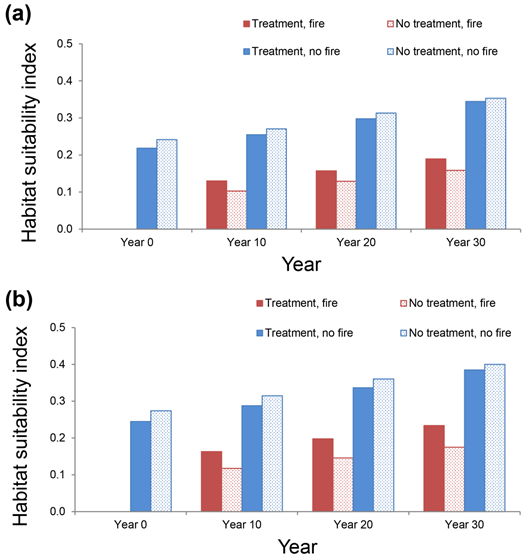
Ecological Archives C006-101-A2
Douglas J. Tempel, R. J. Gutiérrez, John J. Battles, Danny L. Fry, Yanjun Su, Qinghua Guo, Matthew J. Reetz, Sheila A. Whitmore, Gavin M. Jones, Brandon M. Collins, Scott L. Stephens, Maggi Kelly, William J. Berrigan, and M. Zachariah Peery. 2015. Evaluating short- and long-term impacts of fuels treatments and simulated wildfire on an old-forest species. Ecosphere 6:261. http://dx.doi.org/10.1890/es15-00234.1
Appendix B. A figure showing California Spotted Owl (Strix occidentalis occidentalis) habitat suitability index for (a) control and (b) treatment firesheds on a 13,482-ha study area in the Sierra Nevada under four scenarios: (1) no fuel treatments and no wildfire; (2) fuel treatments and no wildfire; (3) no fuel treatments and wildfire; and (4) fuel treatments and wildfire.
Fig. B1. California Spotted Owl (Strix occidentalis occidentalis) habitat suitability index for (a) control and (b) treatment firesheds on a 13,482-ha study area in the Sierra Nevada under four scenarios: (1) no fuel treatments and no wildfire; (2) fuel treatments and no wildfire; (3) no fuel treatments and wildfire; and (4) fuel treatments and wildfire. Year 0 for the “no treatment” scenarios was based on a 2008 pre-treatment vegetation map, and year 0 for the “treatment” scenarios was based on a 2013 post-treatment vegetation map. Simulated fires occurred in year 0 for both the “no treatment” and “treatment” scenarios; thus, fire effects were not present until years 10, 20, and 30.